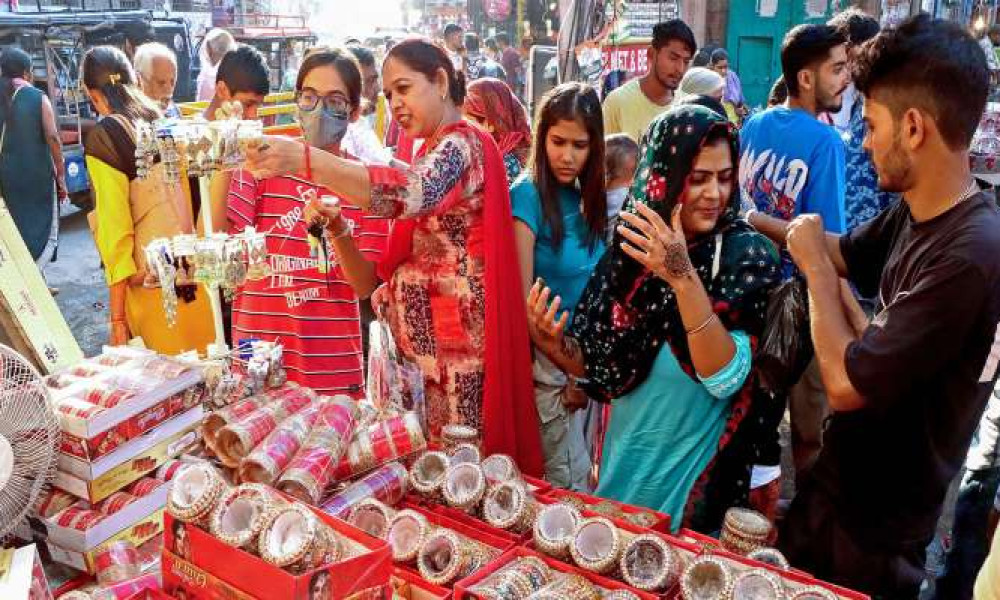India’s Diwali 2025 sales hit an unprecedented Rs 6.05 lakh crore, reflecting robust economic health and a strong Swadeshi spirit. The Confederation of All India Traders (CAIT) released these findings in their comprehensive research report. This marks the highest festive business in the nation’s trading history, showcasing remarkable consumer confidence and market vitality. The report underscores a significant shift towards domestic products and economic self-reliance.
CAIT’s research covered 60 major distribution centers nationwide, including state capitals and Tier 2 & 3 cities. This extensive survey by the CAIT Research & Trade Development Society provides a detailed view of festive spending patterns. It highlights the widespread adoption of Swadeshi ideals across urban and rural markets alike, capturing the essence of a truly national celebration.
Goods sales alone reached Rs 5.40 lakh crore, while services contributed Rs 65,000 crore to the total. These figures represent a 25% increase over last year’s Rs 4.25 lakh crore sales, demonstrating substantial growth in consumer spending. The surge reflects growing economic optimism and disposable income among Indian households, fueling the festive economy.
Prime Minister Narendra Modi has emerged as a strong brand ambassador for GST rationalization and Swadeshi adoption. His leadership has inspired both traders and consumers to embrace domestic products and economic reforms. This alignment between policy and public sentiment has created a powerful momentum for sustainable growth and national pride in local manufacturing.
The Vocal for Local and Swadeshi Diwali campaigns resonated deeply with 87% of consumers preferring Indian-made goods. This overwhelming preference led to a sharp decline in demand for Chinese items, highlighting a conscious shift in consumer behavior. Traders reported a 25% surge in sales of Indian-manufactured products compared to the previous year, validating the success of the Swadeshi movement.
Mainline retail contributed 85% of total trade, underscoring the powerful comeback of India’s physical markets. Non-corporate and traditional markets demonstrated their enduring significance in the economic landscape. Small traders and neighborhood shops played a pivotal role in driving this record-breaking festive performance, proving their resilience and adaptability.
Grocery and FMCG led sectoral sales with 12%, followed by Gold and Jewellery at 10%. Electronics and Electricals accounted for 8%, while Consumer Durables and Ready-made Garments each contributed 7%. Gift items also represented 7% of total sales, showing diverse consumer preferences across product categories during the festive season.
Home Decor and Furniture each accounted for 5% of sales, matching Sweets and Namkeen’s contribution. Textiles and Fabrics contributed 4%, while Pooja Articles, Fruits and Dry Fruits, and Bakery each held 3%. Footwear accounted for 2%, with Other Miscellaneous Items making up the largest share at 19%, demonstrating the wide range of products driving the Swadeshi economy.
The service sector expansion added Rs 65,000 crore to the festive economy. Services including packaging, hospitality, cab services, travel, and event management generated substantial revenue. Tent decoration, manpower, and delivery services also contributed significantly, reflecting the ripple effect of festive spending across multiple sectors and supporting the Swadeshi ecosystem.
GST rate rationalization directly fueled consumer demand, with 72% of traders attributing higher sales to reduced rates. The simplified tax structure on daily-use items, footwear, garments, and consumer durables made products more affordable. Consumers expressed greater satisfaction with stable pricing, which encouraged sustained festive spending and supported the Swadeshi movement.
Trader and consumer sentiments reached a decade high, with the Trader Confidence Index at 8.6 and Consumer Confidence Index at 8.4. Both groups believe the increased consumption trend is sustainable, driven by stable inflation and higher disposable income. Confidence in the national economy remains strong, with expectations that this festive surge will continue through winter and wedding seasons.
The non-corporate, non-agriculture sector comprising over 9 crore small businesses remains India’s growth engine. Diwali 2025 trade created 50 lakh temporary jobs in logistics, packaging, transport, and retail services. Rural and semi-urban India accounted for 28% of total trade, confirming deeper economic participation beyond metropolitan areas and strengthening the Swadeshi foundation.
CAIT recommends simplifying GST compliance and enhancing credit access for small traders. Developing logistics hubs in Tier 2 and 3 cities would further boost economic activity. Promoting low-MDR digital payments and market digitization can streamline transactions. Strengthening urban infrastructure and continuing Swadeshi promotion through coordinated messaging will sustain this momentum.
This historic Diwali symbolized prosperity, nationalism, and economic confidence. Under Prime Minister Modi’s leadership, India’s retail trade sector has proven itself as the backbone of Aatmanirbhar Bharat. The fusion of tradition, technology, and trust has created an unstoppable economic force. The Swadeshi spirit has truly transformed India’s festive economy and consumer behavior.

